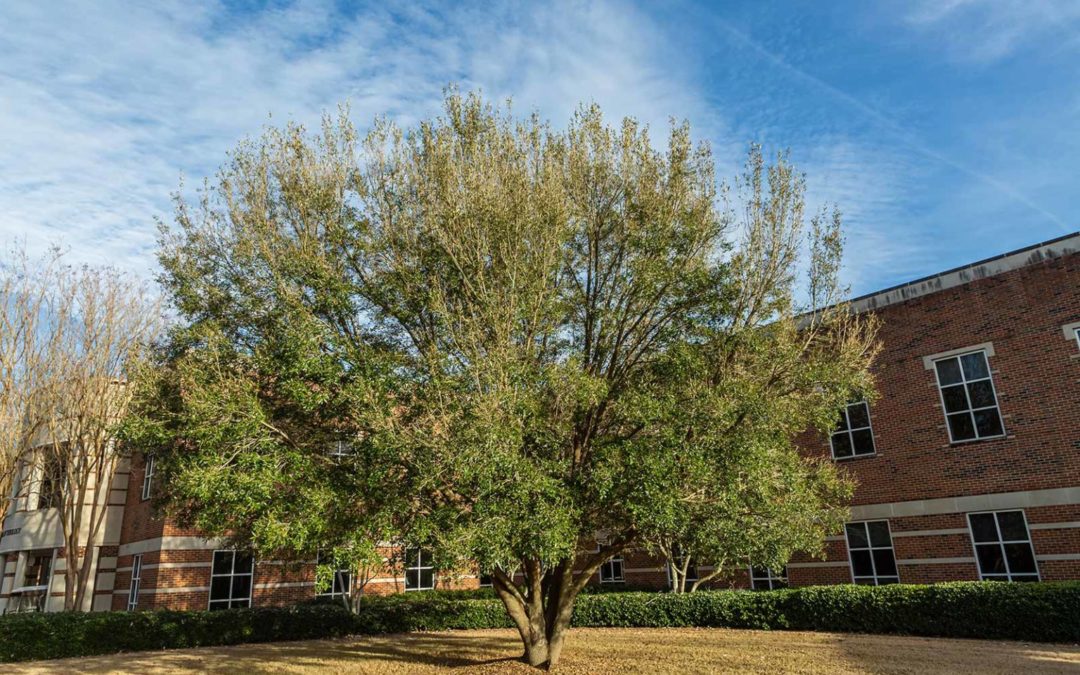It started out, like all oak trees, as a simple acorn. Not all acorns become mighty trees, but this one did. It was celebrated – the acorn – in 1997 as symbolic of the birth of Mercer University’s McAfee School of Theology. The year before, McAfee opened its doors to the first class of students. Twenty-five years later, we are still opening our doors to students preparing for their calling to ministry.
Like the school, the “McAfee Oak” has flourished in many directions, providing shade for Mercer students hanging out, and home to squirrels, chipmunks, blue birds, and humming birds. My office window frames the tree nicely, and in the late afternoon the McAfee Oak filters the sun from overwhelming my desk. It even has it own webpage.
A quarter of a century is not a long time, at least by oak timetables, so it was surprising and upsetting when on a sunny, quiet August morning the McAfee Oak split in two. In spite of a full canopy of green leaves, we all assumed the culprit was some hidden disease, coursing its destruction down to its roots. The arborist, however, said disease was not the cause. It was overall healthy. The problem was that the tree grew multiple trunks going in several directions, and over time it created a hollow place in the center. Through the passage of seasons this hollow place filled with water, and water, without a place to drain or absorb, leads to rot.
Around the office several of us have weighed in with our own interpretive moralisms, metaphors, and similes regarding the demise of the McAfee Oak. Remember, we are all a bunch of preachers! But maybe, like Qoheleth of Ecclesiastes, the season just simply passed for the oak, like a vapor, like a wind. Not one of us – trees and all the rest – are permanent residents.
Of course, it is the hollow place of the McAfee Oak that gives me pause. I think about my own hollow places. Wounds, bitterness, and resentments, have a way of festering, a way of hollowing away in me. Hollow places usually don’t stay hollow. They fill up with debris and clutter and rot. The end is ruin. A colleague of mine often quips, “Grief not transformed is transferred.” The hollow place, unattended, becomes the source of demise. With a quiet “whump” the tree fell, exposing the hollow place and the rot that quietly smothered out life.
Maybe there is no lesson here. Maybe a dead tree is just a dead tree. Perhaps, however, we can at least reflect on the importance of attending to our hollow places, including our institutions like school, like church, like family, like society. We branch out – sorry about the pun – in every direction, not attending to the impact or the consequences on others, failing to understand that precisely what we need in order to flourish, is also what others need too.
“Let us not grow weary,” Paul wrote to the churches of Galatia, “of doing good, for in due season we will reap…” (6:9 NRSV) Attending to the hollow places, let us do some good. I will spare naming out all the “isms” that rot away in all the hollow places in our world and in our souls. It is enough for today, on this gentle day, to do some good on this earth, behind our pulpits, but especially beyond the stained glass. Maybe it is as simple as that – do good for yourself and for one another, and by doing good you take care of those gaping spaces that bring rot and destruction.
In time, like the owl looking to nest, the hollow place can also ripen with life.
Gratefully.
Greg


I will pay more attention to the hollow spots in myself, and this seems to be the season of grief for me. Beginning with Daddy”s death in August all the way to Troy”s birthday in January. It just seems to take longer and longer to ease off. Thanks for the encouragement my friend!
Thank you, Greg. I found this very helpful and meaningful. Love to you and Amy.
Thank you, Greg! Your wisdom, thoughts, analogies are wonderful! My daily prayer is to make someone smile. That helps to fill up some of my hollow places!
The analogy of the acorn to a magnificent spreading oak tree is so appropriate for today. We grow from a tiny cell and during a lifetime, we are exposed to many destructive elements as we spread ourselves over the things we care about the most. Some of our most loved projects can bend or break us. Thank the Lord for allowing us to draw on his strength to hold us together. I hope you will encourage the school to plant another oak there , so that future students and faculty can enjoy its growth, not to mention the wildlife it would attract Thank you for your wisdom. Love to Amy and family.
Perfect! Wise words. Those hollow places can surprise you sometimes! So thankful for a God who is willing and able to fill those spaces. May I allow Him to fill me, overflow, and spill onto those around me. Blessings, my friend!
Not just hollow places, hidden hollow places! When I try to grow two trunks at once, and outsiders admire my strength, I need to remember the reason I need grace and humility.
Keen Berger, Moderator of Judson Memorial Church
I am sorry I am just now seeing this, but that is a very good word you have there! I hope you are having a blessed Advent season.